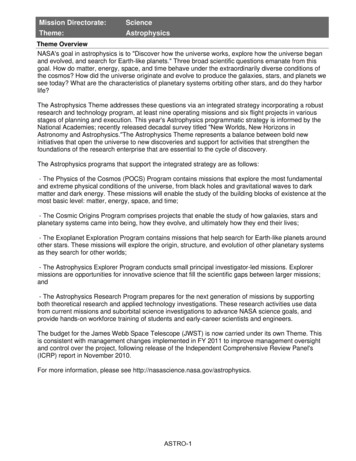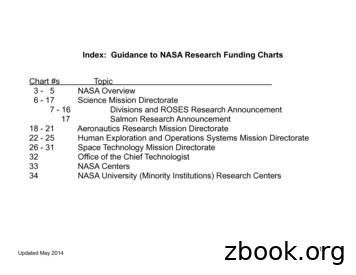Astrophysics Division, Science Mission Directorate Fy 2019 Budget Estimates
ASTROPHYSICS DIVISION, SCIENCE MISSION DIRECTORATEFY 2019 BUDGET ESTIMATESPaul HertzDirector, Astrophysics DivisionScience Mission Directorate@PHertzNASAFEBRUARY 2018
FY 2019 SMD Budget Highlights Advance National Science andExploration Goals Safeguard and Improve Life Execute a Balanced and IntegratedScience Program2
FY 2019 Budget HighlightsAdvance National Scienceand Exploration Goals Execute a new Lunar Discovery andExploration program to leverage commercialpartnerships and innovative approaches toachieve human and science exploration goals Build on extensive past Lunar exploration andscience experience Study concepts for a Mars Sample Returnmission, a decadal survey priority, leveraginginternational and commercial partnerships3
4
FY 2019 Budget HighlightsSafeguard and Improve Life Execute Planetary Defense program for near-Earth objectdetection and mitigation, developing DARTand studying a low-cost space-based near-Earth objectdetection mission Provide additional funding for Space Weather research toimprove forecasting and prediction, and strengthen crossagency collaboration on Research-to-Operations /Operations-to-Research Execute a robust Earth Science program consistent withthe 2017 Decadal Survey Support interagency partners to achieve missions andleverage data obtained from partners (e.g., NOAA, USGS)to further science research5
FY 2019 Budget HighlightsExecute a Balanced andIntegrated Science Program Execute program informed by National Academy of SciencesDecadal Surveys Support for Europa Clipper mission, no funding for EuropaLander Given its significant cost within a proposed lower budget forAstrophysics and competing priorities within NASA, WFIRSTterminated with remaining WFIRST funding redirected towardscompeted astrophysics missions and research Continue leveraging innovation and partnerships, includingSmallSats/CubeSats and commercial efforts Invest in innovative early-stage research and technology topromote economic growth6
FY 2019 BudgetProgram HighlightsPlanetary ScienceAstrophysics New Lunar Discovery andExploration program supportscommercial partnerships andinnovative approaches to achievinghuman & science exploration goals New Planetary Defense programincludes DART development Europa Clipper launch as early asFY25 Study concepts and developtechnology for a potential MarsSample Return mission Webb remains on track for 2019launch Given its significant cost within aproposed lower budget forAstrophysics and competingpriorities within NASA, WFIRSTterminated with remaining WFIRSTfunding redirected towardscompeted astrophysics missionsand researchHeliophysicsEarth Science Space Weather increase willstrengthen cross-agencycollaboration on Research-toOperations/Operations-toResearch Continues focused, balanced Earthscience portfolio Provides for a balancedHeliophysics portfolio, includingenhanced emphasis on smallmissions, technology developmentand expanded opportunities forR&A Healthy research and appliedscience programs, andSmallSat/CubeSat investments Maintains regular cadence ofVenture Class missions andinstruments solicitationsScience budget 2% above the FY17 appropriated level7
Science Budget Request Summary ( M)ScienceActualFY 175,762.2Earth ScienceEarth Science ResearchEarth Systematic 02,143.3247.6150.0Lunar Discovery and 18.0375.0218.0355.6218.0348.5New FrontiersMars 4312.7375.5200.01,185.4310.0312.7Physics of the CosmosExoplanet 8.344.4105.044.9Astrophysics ExplorerHeliophysicsHeliophysics 2.993.2175.6204.1127.8247.994.4Earth System Science PathfinderEarth Science Multi-Mission OperationsEarth Science TechnologyApplied SciencesPlanetary SciencePlanetary Science ResearchPlanetary DefenseOuter Planets and Ocean WorldsTechnologyAstrophysicsAstrophysics ResearchCosmic OriginsLiving with a StarSolar Terrestrial ProbesHeliophysics Explorer ProgramEnactedFY 18RequestFY 195,895.0FY 205,859.9NotionalFY 21FY FY 235,803.61,784.2537.8595.08
Science Mission DirectorateAstrophysics9
Astrophysics OverviewStrategic Objective Discover how the Universe works, explore how it began and evolved, andsearch for life on planets around other starsMajor Activities Building, launching, and operating strategic and competed spaceobservatories, many with international partners Developing technologies to enable future observatories, both large and small– Basic R&D as well as focused technology development Conducting and sponsoring cutting-edge research, mission enabling studies,technology demonstrations, and workforce development– Suborbital-class projects using scientific balloons, sounding rockets,SmallSats/CubeSats, International Space Station, and other platforms– Analysis of data from NASA and partner space observatories– Theoretical and computational investigations– Laboratory experiments in support of astrophysical understanding10
Major Recent Accomplishments FY17-18 IXPE downselected January 2017 as next Astrophysics Small Explorer (SMEX) mission Seven Earth-sized planets, three in habitable zone, discovered orbiting red dwarf star TRAPPIST-1 bySpitzer February 2017 Two missions launched to ISS– Neutron Star Interior Composition Explorer (NICER) June 2017– Cosmic Ray Energetics and Mass (CREAM) August 2017 Final Kepler prime-mission catalog, containing 4,000 exoplanet candidates, released June 2017 Three Medium-class Explorer (MIDEX) and three Mission of Opportunity proposals selected August 2017for competitive Phase A concept studies Gravitational waves and light detected from a kilonova caused by two merging neutron stars August 2017 WFIRST Independent External Technical/Management/Cost Review (WIETR) completed November 2017 Webb payload completed cryotesting and Webb sunshield integrated with spacecraft December 2017, ontrack for 2019 launch XARM passed KDP-C January 2018 and began implementation TESS completed testing, on track for April 2018 launch11
James Webb Space Telescope Civilization-scale mission to observe firstgalaxies formed after Big Bang Science payload completed three monthscryogenic testing at end of 2017 Spacecraft and sunshield integration completeJanuary 2018 Science payload and spacecraft integrationplanned Summer 2018 Launch scheduled for 201912
Astrophysics Budget FeaturesWhat’s Changed Webb included as project within Astrophysics budget, remains on track and within budget for 2019 launch Given its significant cost within a proposed lower budget for Astrophysics and competing priorities withinNASA, WFIRST terminated with remaining WFIRST funding redirected towards competed astrophysicsmissions and research Euclid budget increased to recover from failed sensor electronics design XARM begun within Explorers program Spitzer ops extended until Webb is operational, consistent with 2016 Senior ReviewWhat’s the Same TESS, IXPE, and GUSTO remain on track and within budget All 11 operating missions continue; next Senior Review in 2019 CubeSat initiative and four balloon campaigns within healthy research program13
WFIRST Given its significant cost within a proposed lowerbudget for Astrophysics and competing prioritieswithin NASA, WFIRST terminated with remainingWFIRST funding redirected towards competedastrophysics missions and research Funds appropriated by Congress in FY18 will allowWFIRST to enter Phase B in April 2018 If Congress adopts the Administration’s request toterminate WFIRST, the funds made available wouldenable a competed probe-class mission AO in FY19
WFIRST Terminated “Given competing priorities at NASA, and budget constraints, developing another large space telescopeimmediately after completing the 8.8 billion James Webb Space Telescope is not a priority for theAdministration.” White House FY19 Budget Request document 8/02/msar-fy2019.pdf) “We did have to make some hard decisions in science. This budget proposes cancelling our WFIRST missionand taking those resources and redirecting them to other agency priorities.” Robert Lightfoot, Acting Administrator, “State of NASA” address, February 12, 2018 “Given its significant cost and higher priorities within NASA, the budget proposes termination of the WFIRSTmission. Remaining WFIRST funding is redirected towards other priorities of the astrophysics community,including competed astrophysics missions and research.” NASA FY19 Budget Estimates les/fy19 nasa budget estimates.pdf)15
Planned Accomplishments FY18-19 TESS will launch April 2018 Funds appropriated by Congress in FY18 will allow WFIRST to enter Phase B in April 2018 IXPE will complete preliminary design review and enter Phase C Fall 2018Next MIDEX and Mission of Opportunity missions will be downselected by January 2019Decadal Survey will begin January 2019Webb will complete observatory integration and will launch in 2019Senior Review will be conducted Spring 2019If Congress approves the Administration’s request to terminate WFIRST, the funds madeavailable would enable a competed probe-class mission AO in FY1916
17
KeplerSpitzerFormulationImplementationPrimary OpsExtended OpsWebb(2019)Euclid (ESA)(2020)ChandraTESS(2018)XMM-Newton (ESA)Gehrels SwiftObservatoryNuSTARHubbleXARM (JAXA)(2021)Defined by FY19 Budget RequestAs of Feb. 6, FIA18
Astrophysics Program ContentAstrophysicsAstrophysics ResearchScience ActivationAstrophysics Research and AnalysisBalloon ProjectOther Missions and Data AnalysisAstrophysics Data Curation and ArchivalAstrophysics Data ProgramAstrophysics Senior ReviewContract Administration, Audit & QA SvcsActualFY 17RequestFY 19FY 16.82.218.42.218.42.218.42.212.6Astrophysics Directed R&TCosmic OriginsHubble Space TelescopeSOFIAJames Webb Space TelescopeOther Missions and Data AnalysisCosmic Origins Future MissionsSpitzerHerschelCosmic Origins SR&TCosmic Origins Program ManagementNotionalFY 21FY 22FY 2319
Astrophysics Program Content (cont’d)ActualFY 17RequestFY 19FY 20106.2136.8139.1EuclidPhysics of the Cosmos Future MissionsChandra X-Ray ObservatoryFermi Gamma-ray Space 14.0XMMPlanckPhysics of the Cosmos SR&TPhysics of the Cosmos Program 2.621.25.9Physics of the CosmosExoplanet ExplorationWFIRSTExoplanet Exploration Future MissionsKeplerKeck OperationsLarge Binocular Telescope InterferometerExoplanet Exploration SR&TExoplanet Exploration Program MgmtNotionalFY 21FY 22FY 38.07.88.07.98.320
Astrophysics Program Content (cont’d)Astrophysics ExplorerTransiting Exoplanet Survey SatelliteImaging X-Ray Polarimetry ExplorerOther Missions and Data AnalysisGUSTOAstrophysics Explorer Future MissionsNuclear Spectroscopic Telescope ArraySwiftNICERAstrophysics Explorer Program MgmtActualFY 17RequestFY 19FY 20NotionalFY 21FY 22FY 6.63.5385.24.2408.68.511.87.910.1398.521
ASTROPHYSICS DIVISION, SCIENCE MISSION DIRECTORATE. FY 2019 BUDGET ESTIMATES. Paul Hertz. Director, Astrophysics Division. Science Mission Directorate @PHertzNASA. FEBRUARY 2018. . Earth Science Multi-Mission Operations 204.9 196.9 208.7 225.0 231.6 237.1 Earth Science Technology 62.9 59.7 61.6 64.2 67.8 69.6 .
Astrophysics also receives tactical-level advice from the external science community via the Astrophysics Subcommittee of the NASA Advisory Council, and advice on cooperative activities from the Congressionally chartered, National Science Foundation (NSF)-managed Astronomy and Astrophysics Advisory Committee. NASA enables research to understand the structure, content, and evolution of the .
Carroll & Ostlie, An Introduction to Modern Astrophysics Hilditch, An introduction to close binary stars Both on closed reserve in SciTech library. Lecture 1: Astrophysics Introduction 7 / 35. Astrophysics Astrophysics is a big subject. Sometimes will just flag where a whole (possibly large!) field branches
6 - 17 Science Mission Directorate 7 - 16 Divisions and ROSES Research Announcement 17 Salmon Research Announcement 18 - 21 Aeronautics Research Mission Directorate 22 - 25 Human Exploration and Operations Systems Mission Directorate 26 - 31 Space Technology Mission Directorate 32 Office of the Chief Technologist
Astrophysics always offers a large range of M.Phys projects, from technical work in radio and optical astronomy through observational work with the Wetton telescope to numerical simulations, modelling and theory. We always ensure that every C1 student who wishes to do an astrophysics M.Phys. project is catered for. Astrophysics is a very sociable department! C1 students are encouraged to .
Astrophysics Research Institute The Astrophysics Research Institute (ARI) is one of the world’s leading authorities in astronomy and astrophysics. Its work encompasses a comprehensive programme of observational and theoretical research, telescope operation, instrument development, academic learning and outreach activities. The ARI has been honoured with various awards and prizes including: n .
NASA SPACE TECHNOLOGY MISSION DIRECTORATE - Dr. Michael Gazarik, Associate Administrator, Space Technology Mission Directorate Dr. Michael Gazarik, NASA Associate Administrator for the Space Technology Mission Directorate (STMD), provided the update. He said STMD is the newest directorate at NASA, a little over a year old.
NNH20ZHA001C NASA EPSCoR Rapid Response Research (R3) 4 Introduction NASA’s Office of STEM Engagement (OSTEM), in collaboration with the Aeronautics Research Mission Directorate (ARMD), Science Mission Directorate (SMD) Planetary Science Division, Earth Science Division, Biological and Physical Sciences Division, Space Technology
The API Specification and the EEMUA Specification differ slightly in some respects. The main differences in the specifications are in the requirements for the rheological properties and filtrate loss of the slurry. The rheological properties of the slurry at different rates of shear are determined using a direct reading viscometer. Filtrate loss is determined using a filter press. Test methods .























